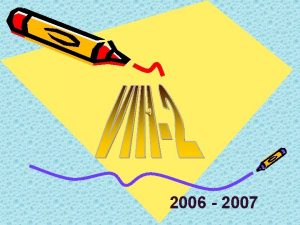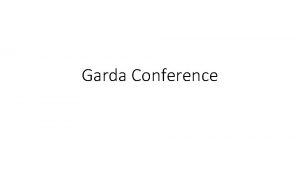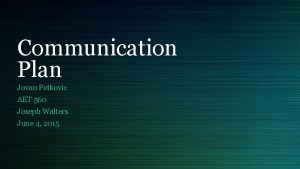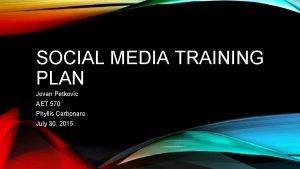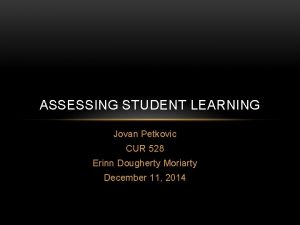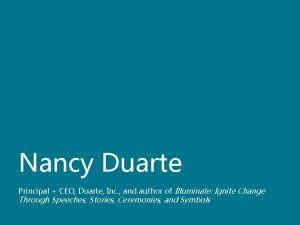Communication Presentation Jovan Petkovic Thomas Hurley Steve Duarte















- Slides: 15

Communication Presentation Jovan Petkovic Thomas Hurley Steve Duarte Andrew Runge

Introduction • The guide will assist in identifying elements to fine tune business communication. An short review of history in communication and present expectations are identified.

Primary purpose of organizational communication • The primary purpose for organizational communication is to effectively and accurately relay information from one body to another body. The body can be an individual, group, team, or customer.

Five basic criteria for effective business communication

Professionalism • Academic Behavior and ethics • Empirical study • Cruess & Cruess on general principles to teaching professionalism • Institutional support • Cognitive base

Professionalism (cont’d) • Experiential learning • Continuity • Role Modeling • Faculty development • Evaluation • Environment

Business Etiquette – In the Workplace • “The Unwritten Rules of Business Success” 1. 2. 3. 4. 5. 6. 7. 8. 9. 10. 11. 12. Don’t be on time – be early! Underpromise – then overdeliver Be greeting-savvy Think before you speak Make the connection Dress for the position you want - not the one you have Know when to choose traditional business attire Make your accessories count Follow proper meeting protocol Make Voicemail work for you Follow e-mail etiquette Put your best fork forward

Business Etiquette – In Social Settings • The Donald Sterling Scandal

Business Etiquette – Online • Facebook: Challenges and opportunities

Audience-centered approach • Reading body language • Nonverbal versus verbal communication • Understanding communication styles • Analytical • Visual • Interactive

Technology implementation • Different types of technology that can be incorporated such as: • • Computers Internet/intranet Telephones, Voice over IP (VOIP), Smart phones Projectors, wireless technology • Internal communication, email, instant message, Power. Point • Technological combinations, such as multimedia presentations/webinars/Skype • Balancing the use of technology with the human element • Using software for editing and proofing before publication.

Cultural diversity • The importance of cultural awareness • Within the workforce • Within the consumer base • Annual and semi-annual refresher training • Skillsoft computer based training modules • Conferences and small group training/discussion • Identifying cultures • Major cultures • Minor cultures • Cultural differences • Cultural similarities

Questions and answers

References Decarie, C. (2010). Facebook: Challenges and Opportunities for Business Communication Students. Business Communication Quarterly, 73(4), 449 -452. doi: 10. 1177/1080569910385383 Sabath, A. (2007). Workplace etiquette: The unwritten rules of business success. Employment Relations Today (Wiley), 34(2), 53 -59. doi: 10. 1002/ert. 20152 Mausehund, J. , Dortch, R. , Brown, P. , & Bridges, C. (1995). Business etiquette: What your students don't know. Business Communication Quarterly, 58(4), 34 -38. Carballal-Benaglio, C. (2013, Summer). Cultural diversity: Making intercultural collaboration possible for multinational corporations. Law and Business Review of the Americas, 19(3), 293 -294. Retrieved from http: //search. proquest. com. ezproxy. apollolibrary. com/docview/1498243736? accountid=458 Cruess, R. L. , & Cruess, S. R. (2006). Teaching professionalism: General principles. Medical Teacher, 28(3), 205 -208. Retrieved from http: //dx. doi. org/10. 1080/01421590600643653 London, H. (1997, December). What happened to professionalism? Academic Questions, 10(4), 43 -46. Retrieved from http: //dx. doi. org/10. 1007/s 12129 -997 -1119 -8 Lusch, R. F. , & O’Brien, M. (1997, Spring). Fostering professionalism. Marketing Research, 9(1), 24 -31. Retrieved from http: //search. proquest. com. ezproxy. apollolibrary. com/docview/202676050? accountid=458 Van Genderen, E. (2013). Emotional intelligence, communication, and technology: Defining the new professional. Middle East Journal Of Business, 8(4), 3 -7. Retrieved from http: //search. ebscohost. com. ezproxy. apollolibrary. com/login. aspx? direct=true&db=bth&AN=91750765&site=ehost-live

References continued Cáceres, R. , Agüero, A. , Cavero, M. , & Huaroto, C. (2012). The impacts of the use of mobile telephone technology on the productivity of micro- and small enterprises: An exploratory study into the carpentry and cabinetmaking sector in Villa El Salvador. Information Technologies & International Development, 8(4), 77 -94. Retrieved from http: //search. ebscohost. com. ezproxy. apollolibrary. com/login. aspx? direct=true&db=bth&AN=89132127&site=ehost-live Stowers, R. H. , & Hummel, J. Y. (2011). The use of technology to combat plagiarism in business communication classes. Business Communication Quarterly, 74(2), 164 -169. doi: 10. 1177/1080569911404406 Taylor, V. E. (2010). Broadening participation: Cultivating cultural diversity in information technology. Communications of the ACM, 53(7), 35 -36. doi: 10. 1145/1785414. 1785430 Wood, P. A. (2005). How to read and respond to your audience’s body language. Consulting to management, 16(4), 28 -29. Retrieved from http: //search. proquest. com/docview/215898916? accountid=35812 Davies, R. (2007). Understanding your audience. Administrative assistant's update, 3(3), 5. Retrieved from http: //search. proquest. com/docview/225228064? accountid=35812 Peterson, R. T. (2005). An examination of the relative effectiveness of training in nonverbal communication: Personal selling implications. Journal of Marketing Education, 27(2), 143 -150. Retrieved from http: //search. proquest. com/docview/204409183? accountid=35812 Das Neves, J. C. , & Melé, D. (2013). Managing ethically cultural diversity: Learning from Thomas Aquinas. Journal of Business Ethics, 116(4), 769 -780. doi: http: //dx. doi. org/10. 1007/s 10551 -013 -1820 -1 c

